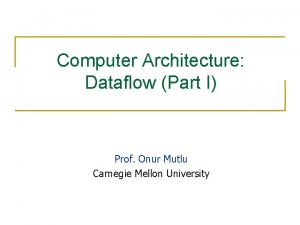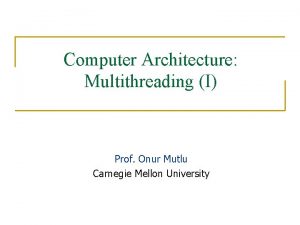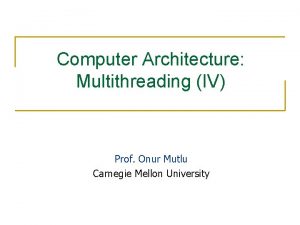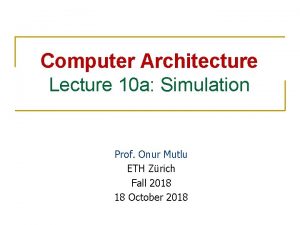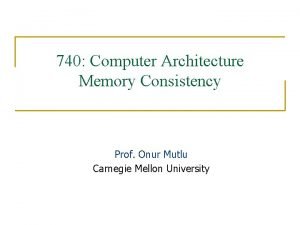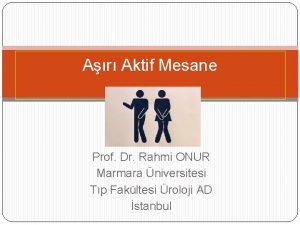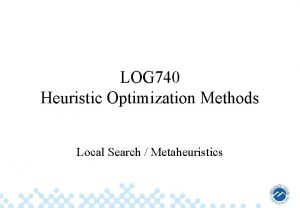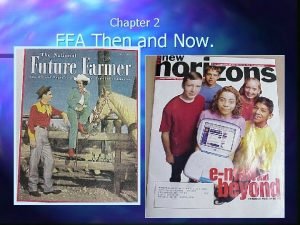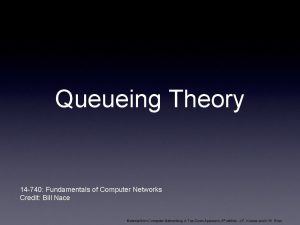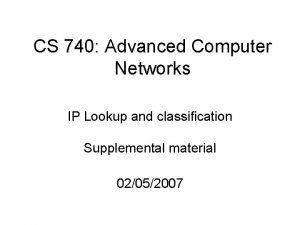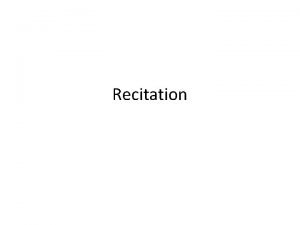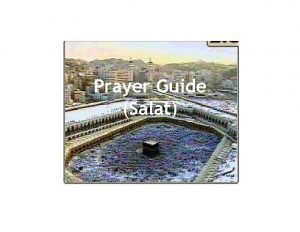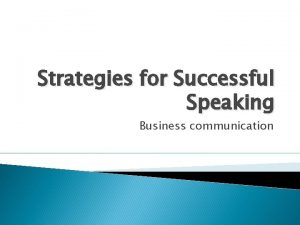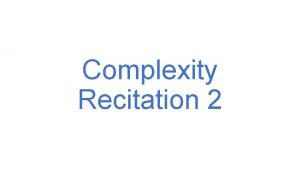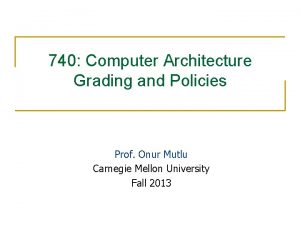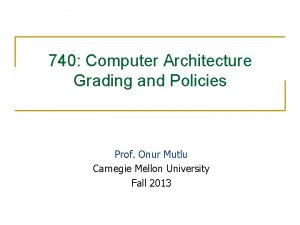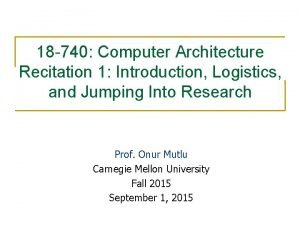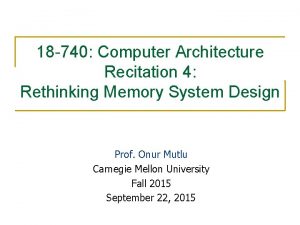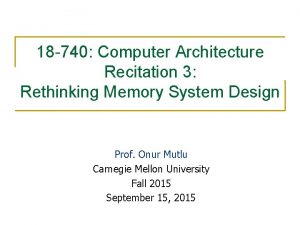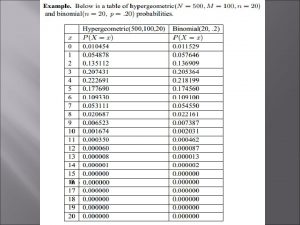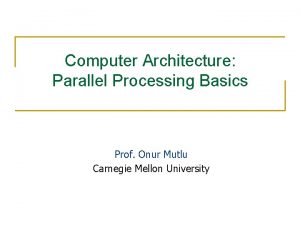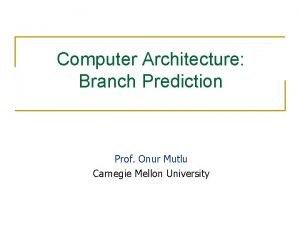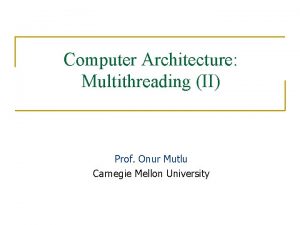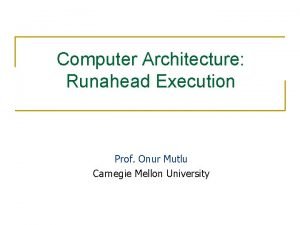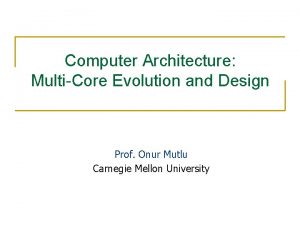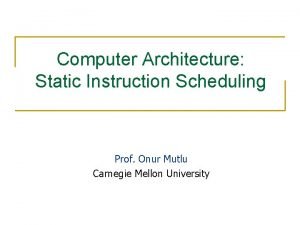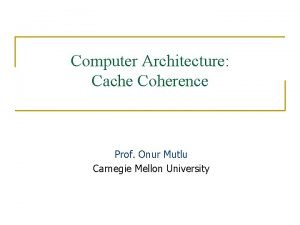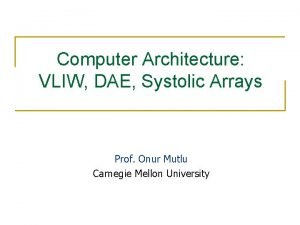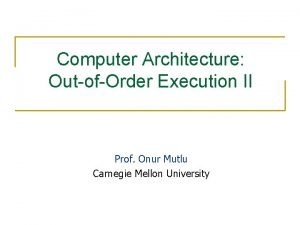18 740 Computer Architecture Last Recitation Prof Onur























- Slides: 23

18 -740: Computer Architecture Last Recitation Prof. Onur Mutlu Carnegie Mellon University Fall 2015 December 1, 2015

Agenda n Agenda for the next few weeks n Review assignments for this week and the next n Upcoming events (talks) n On writing and presentation n Questions 2

Agenda for the Next Few Weeks n No recitation or office hours next week: MICRO 2015 n Last lecture: December 7, Monday n Focus on your projects and reviews next week 3

Project Timeline n Project poster and presentation session q q n Project reports due q n Monday, December 14: 2 -6 pm (tentative) Stay tuned for more information Sunday, December 20: 11: 59 pm Idea: Take the feedback from the poster/presentation and improve your project during the last stretch 4

Agenda n Agenda for the next few weeks n Review assignments for this week and the next n Upcoming events (talks) n On writing and presentation n Questions 5

Talk Tomorrow (CALCM Seminar) n 1 pm, CIC Panther Hollow Conference Room (4 th floor) n Data Flow Supercomputing for Big Data q q n n n Prof. Veljko Milutinovic, Univ. of Belgrade https: //www. ece. cmu. edu/~calcm/doku. php? id=seminars: sem inar_12_2_15 Followed by a demo session on Maxeler Please attend Enter optional review on website 6

Reviews for December 8 n n n Hirata et al. , “An Elementary Processor Architecture with Simultaneous Instruction Issuing from Multiple Threads, ” ISCA 1992. Tullsen et al. , “Simultaneous Multithreading: Maximizing On -Chip Parallelism, ” ISCA 1996. Levin and Redell, “How (and How Not) to Write a Good Systems Paper, ” Operating Systems Review 1983. 7

Optional Reading n Peyton-Jones, “How to give a good research talk, How to write a great research paper, How to write a good research proposal, ” q n http: //research. microsoft. com/enus/um/people/simonpj/papers/giving-a-talk. htm Hamming, “You and Your Research, ” 1986. q http: //www. cs. virginia. edu/~robins/You. And. Your. Research. html 8

Agenda n Agenda for the next few weeks n Review assignments for this week and the next n Upcoming events (talks) n On writing and presentation n Questions 9

More Computer Architecture Seminars n Multiple seminars on Dec 14, 15 n Stay tuned. 10

Agenda n Agenda for the next few weeks n Review assignments for this week and the next n Upcoming events (talks) n On writing and presentation n Questions 11

A Paragraph The procedure is actually quite simple. First you arrange things into different groups. Of course, one pile may be sufficient depending on how much there is to do. If you have to go somewhere else due to lack of facilities that is the next step, otherwise you are pretty well set. It is important not to overdo things. That is, it is better to do too few things at once than too many. In the short run this may not seem important bu complications can easily arise. A mistake can be expensive as well. At first the whole procedure will seem complicated. Soon, however, it will become just another facet of life. It is difficult to foresee any end to the necessity for this task in the immediate future, but then one never can tell, After the procedure is completed one arranges the materials into different groups again. Then they can be put into their appropriate places. Eventually they will be used once more and the whole cycle will then have to be repeated. However, that is part of life. 12

Question n What was this paragraph about? n Do you recall it? 13

What If I Told You Afterwards … n Do you understand it now? n Do you recall it? 14

Washing Clothes The procedure is actually quite simple. First you arrange things into different groups. Of course, one pile may be sufficient depending on how much there is to do. If you have to go somewhere else due to lack of facilities that is the next step, otherwise you are pretty well set. It is important not to overdo things. That is, it is better to do too few things at once than too many. In the short run this may not seem important bu complications can easily arise. A mistake can be expensive as well. At first the whole procedure will seem complicated. Soon, however, it will become just another facet of life. It is difficult to foresee any end to the necessity for this task in the immediate future, but then one never can tell, After the procedure is completed one arranges the materials into different groups again. Then they can be put into their appropriate places. Eventually they will be used once more and the whole cycle will then have to be repeated. However, that is part of life. 15

Question n What was this paragraph about? n Do you recall it? 16

For More n Bransford, J. D. , & Johnson, M. K. (1972). Contextual prerequisites for understanding: Some investigations of comprehension and recall. Journal of Verbal Learning and Verbal Behavior, 11, 717 -726. 17

My Research Paper Guidelines n 1. You are writing for the reader (not for yourself). q n n Reader is someone who does not have background on the topic, who is extremely busy, and who wants to get the key points quickly. They are smart, but you cannot assume they know and they will magically interpret everything the way you think they would interpret them. Which means you need to give them a lot of context and hold their hand in explanations. 2. Give the high level first, and then go into the low level. Give an overview first and set the context, and then go into components. 3. You are writing to bring about the insights. Be explicit about the key insights, key problems, key ideas, key goals. Do not hide them. Be direct. 18

My Research Paper Guidelines (II) n n 4. Illustrate with figures. Motivation, key idea, mechanism can all be illustrated. Figures should be self explanatory. 5. Be methodical. 19

An Outline for Any Introduction n n n The problem you are solving needs to be clear from the getgo. Why it is important needs to be clear right afterwards (perhaps with a motivational figure). Then, your goal in the paper, clearly defined. Then, the key ideas you develop to solve the problem (in more detail than the abstract). Then, the mechanisms (at a high level, but again in more detail than the abstract). Then, the key experimental results (with thorough descriptions of the comparison points). And, finally, end with contributions. 20

An Algorithm for the Results Section Write Section Title Write Insightful Overview Paragraph While there are insightful results to present write { q q q Insightful section title "To show [. . . ], we study [. . . ]. . . [explain what the study is and what the goal is, if needed] Figure XXX shows. . . [explain carefully what the figure shows, what the metrics are, what x and y axes are] We make N major observations. First, . . . [explain with insight and reasoning]. Second, . . . Third, . . . , [. . . ] Finally, … We conclude that. . . [draw a final conclusion] } 21

A Full Paper n Is an expansion of the introduction. n A paper is the artwork of a researcher. q Treat it as a caring artist treats their artwork: optimize and perfect every piece of it. 22

18 -740: Computer Architecture Last Recitation Prof. Onur Mutlu Carnegie Mellon University Fall 2015 December 1, 2015
 Data flow architecture
Data flow architecture Computer architecture onur mutlu
Computer architecture onur mutlu Prof. onur mutlu
Prof. onur mutlu Onur mutlu computer architecture
Onur mutlu computer architecture Onur mutlu computer architecture
Onur mutlu computer architecture Perkütan tibial sinir stimülasyonu
Perkütan tibial sinir stimülasyonu Asc 740
Asc 740 Sfas 109
Sfas 109 Outside basis difference
Outside basis difference 740
740 Gabriel deloitte
Gabriel deloitte Who wrote the ffa creed? when was it adopted?
Who wrote the ffa creed? when was it adopted? 14-740
14-740 F 740
F 740 Dell 740r
Dell 740r Cs 740
Cs 740 Active recitation
Active recitation Sajjdah
Sajjdah Impromptu speaking business
Impromptu speaking business Learning objectives of poem recitation
Learning objectives of poem recitation Reciting a poem
Reciting a poem What is meant by etiquette of recitation of the holy quran
What is meant by etiquette of recitation of the holy quran Recitation les machines
Recitation les machines What is performance marketing
What is performance marketing
